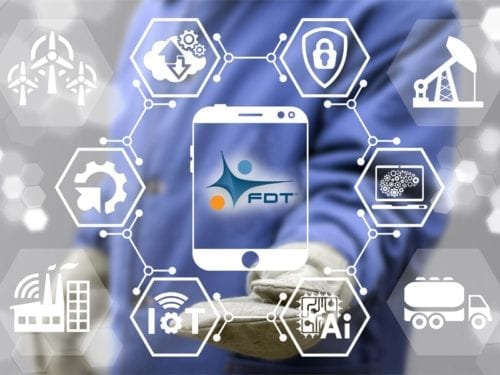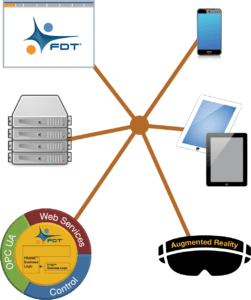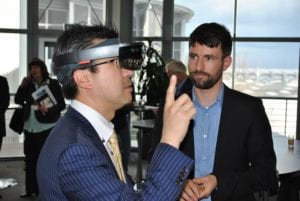
FDT Standardized Mobility Solutions and User Interface for Agile Operations
Web Services portal empowers maintenance personnel with flexible approach for cloud-based enterprise data access, mobility apps and augmented reality
Mobile technology is transforming the manufacturing environment. This trend is accelerated by the Industrial Internet of Things (IIoT) and Industrie 4.0 initiatives whose goal is to empower an intelligent enterprise through a smart, connected automation ecosystem.
The following article describes how ongoing technology developments by FDT Group will help optimize industrial organizations and their maintenance departments by enabling cloud-based enterprise data access, robust device diagnostics, mobility applications, and the use of augmented reality in asset management and predictive maintenance programs.
Today’s Industrial Demands
Nowadays, most maintenance departments are caught between budget and cost pressures on the one hand, and increasing business requirements (e.g., regarding the availability of production plants and assets) on the other hand. In order to increase the performance capacity and efficiency of maintenance operations, appropriate processes and systems as well as adequately structured data management are needed.

Figure 1: Today, mobility solutions are dramatically changing the landscape of plants and factories.
Businesses and consumers have realized the value of mobility in the way they access, analyze and interact with data. The manufacturing world is no different. Flexibility is critical on the modern manufacturing floor, and mobile platforms can provide the support needed by these organizations and their customers.
Just as mobile devices are transforming the way each of us communicates and connects, mobility solutions are dramatically changing the landscape of plants and factories. With visibility, information and control literally in workers’ hands, plant processes and productivity are transformed (See Fig. 1).
Technology Enabling Field Technicians
FDT Group, an independent, international, not-for-profit industry association consisting of leading companies and organizations active in industrial automation and manufacturing, continues to advance its open standard for enterprise-wide network and asset integration. The organization was founded in 2003 for integration and lifecycle management of devices, and today it provides a uniform interface supporting connection to any device on the market from any network and any device vendor.
FDT technology provides a common environment for utilizing intelligent devices’ most sophisticated features, as well as a single interface to integrate any device asset and network with access to performance-driven data – sensor to enterprise. Within the FDT ecosystem device manufacturers provide Device Type Manager™ (DTM™) software for their products, and the FDT/FRAME™ (embedded in control systems or standalone device management tools) communicates and reads those FDT/DTMs – regardless of protocol for each device. This enables complete lifecycle access for configuration, operation and maintenance through a standardized user interface, no matter the supplier, device type/function, or communication protocol.
Today, FDT is the leading device integration technology standardized internationally and widely adopted in the process, hybrid and factory automation markets with tens of thousands of FRAME-enabled applications and millions of DTMs installed and working to provide seamless integration and intelligent driven operations.
To support next-generation solutions in the era of IIoT and Industrie 4.0, FDT Group is developing a solution known as “FITS™” (FDT IIoT Server). The FITS solution protects industry investments in FDT through advanced business logic, well-defined interfaces and common components, and enables operating system (OS) agnostic implementation of the technology while supporting today’s integrated automation architecture. The IIoT server employs FRAME and DTM business logic at the heart of its client-server architecture and can scale to suit the needs of a single manufacturing facility or an entire industrial enterprise.
FITS implements OPC UA natively to enable mobility, cloud, and fog enterprise applications, as well as sensor-to-cloud and enterprise-wide connectivity – making it possible to share information between higher-level applications and the server architecture. Using FDT-enabled control solutions, which can be configured using the open OPC Unified Architecture (UA) protocol, the management of networks and devices is enhanced, giving access to data at all levels in the enterprise without protocol-specific handling and providing support for a wide range of devices.
Thanks to FDT, the ability to integrate diverse plant information enables personnel to mitigate process upsets and instrument malfunctions. The combination of measured values, valve openings and device diagnostics helps identify specific deviations in operation and instrument performance. This level of interoperability and true advanced diagnostics is optimizing modern plant and factory operations.
Web Services Focused on Mobility
FDT Group is dedicated to meeting the requirements for mobile device connectivity on the industrial shop floor and in the field. Its goal is to enable automation end users to employ the functionality they appreciate in the FDT integration standard on all of the leading mobile platforms. This mobility integration will provide access to additional data – at any time and anywhere – with flexible deployment options.

Figure 2. FDT has created a standardized approach for mobile access using browser technology or apps where the mobile device can be authenticated to access the FITS server.
The FDT/FRAME and FDT/DTM are at the core of the FITS server and surrounded by three portals: Web Services, OPC UA and Control. For the purposes of this article, the discussion will focus on the Web Services portal designed to mobilize industrial maintenance personnel. FDT mobility takes the technology’s founding principles and empowers the industrial workforce with agile operations optimizing process efficiencies.
FDT Web Services provides a standardized mobile access approach utilizing browsers, apps, standalone applications, or anything else capable of interfacing via web sockets. Users can take advantage of standard browsers to gain access to DTMs and FRAME-enabled systems, or write custom apps and programs (See Fig. 2).
Tools for a Smarter Workforce
For the simplest to the most complex maintenance operations, FDT-enabled mobile applications will empower plant personnel to work smarter, faster and more effectively. They will gain the ability to complete tasks and record notes directly at the instruments they are maintaining and repairing. In fact, field workers who use mobile devices to access equipment maintenance data will report more frequently and with higher accuracy.
With apps employing FITS Web Services, for example, maintenance technicians will no longer be bound to a centralized tool or handheld device connected to an individual instrument; instead, they can use tablets, smart phones and other mobile devices to carry out their daily activities. This includes solutions bringing FDT data much closer to the engineer or technician, and enabling troubleshooting and monitoring of instruments’ critical operating parameters to be performed remotely to ensure they are functioning according to specification. Additional maintenance benefits will include the ability for field workers to take pictures or scan bar codes with their secure, authenticated smart phones or tablets to provide a host of device-specific information. Programmers will have the option to write algorithms to simplify reporting.

Figure 3: Combining cloud services with mobile apps and the use of augmented reality via a holographic human-machine Interface (HMI) will further address life-cycle management issues.
Beyond cloud services with mobile applications, the use of augmented reality via a holographic human-machine Interface (HMI) and Microsoft’s HoloLens computing device will further address critical lifecycle management issues. Augmented reality is aimed at increasing context-sensitive human perception so as to relocate information transfer, as well as the traditional, screen-based operation of machines, into space itself. Consequently, technicians are able to view real-time data and analytics using hands-free operation, visualizing status and live data for each sensor location. They have a normal field of view using transparent glasses with the virtual content superimposed over the real or physical content (See Fig. 3).
Conclusion
FDT Group developed the FITS architecture to optimize the scale and functionality of the IIoT capabilities of its technology stack for enterprise-wide network and asset integration, as well as diverse control system connectivity. FITS is now set to empower the industrial workforce with flexible deployment and mobility solutions intended to optimize facilities wth agile operations.
With the advanced FITS architecture, FDT maintains its core communication and diagnostic capabilities, but also offers secure remote access to data through mobile devices and web sockets so that other applications can take part in the seamless exchange of information. Indeed, FITS will open the automation architecture to allow for more points of access from a data and user interface perspective.